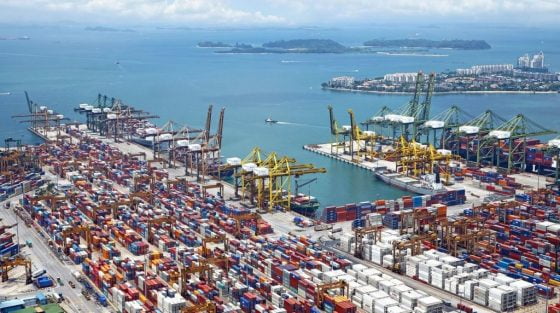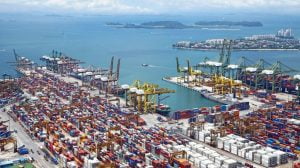
TRUMP SAYS: HUNTER MAKES FORTUNE FROM SHADY DEALS!
BIDEN FAMILY STINKS TO HIGH HEAVENS OF CORRUPTION!
DON'T GET LEFT OUT: HUNTER MUST BE STOPPED!

This article was originally published by Ryan McMaken at The Mises Institute.

It seems supporters of the Biden administration finally settled on a narrative they like for explaining away supply chain shortages.
Here’s the administration’s talking point: the US economy is rolling along so well that Americans are demanding huge amounts of goods. That’s overwhelming the supply chain and causing the backups roiling America’s ports and logistic infrastructure.
For example, transportation secretary Buttigieg this month declared “Demand is up … because income is up, because the president has successfully guided this economy out of the teeth of a terrifying recession.”
Similarly, White House spokeswoman Jen Psaki told reporters supply chain problems are occurring because “people have more money … their wages are up … we’ve seen an economic recovery that is underway.”
This position has been mocked by a number of conservative politicians—including Senator Ted Cruz—and commentators, who find this to be an absurd assumption. Indeed, Cruz and other critics could point to a variety of factors ranging from the weight of government regulations to the problem of covid lockdowns limiting the productivity of supply-chain workers.
Yet the administrator’s defenders are right about consumer demand and spending—even if for the wrong reasons. As Mihai Macovei showed earlier this month, the global volume of trade and shipping volume in 2021 have actually exceeded prepandemic numbers. For example, in the port of Los Angeles, “loaded imports” and “total imports” for the 2020–21 fiscal year (ending June 30, 2021) were both up when compared to the same period of the 2018–19 fiscal year.
In other words, it’s not as if little is moving through these ports. In fact, more is moving through them than ever before. That suggests demand is indeed higher.
But why is it higher? It some ways, it’s true that, as Psaki says, “people have more money.” That, however, is where the veracity and usefulness of Biden’s defenders end in explaining the problem.
Much of the answer can be really found in monetary inflation. Obviously, Joe Biden hasn’t “successfully guided the economy” through anything, but it is accurate to say that people have more money in a nominal sense. Wages are up nominally. After all, if we look at the immense amount of new money created over the past eighteen months, we should absolutely expect people to have more money sloshing around. But this also means a lot more pressure on the logistical infrastructure as people buy up more consumer goods.
The idea that supply chain problems are “driving inflation” gets the causation backward. It’s money supply inflation that’s causing much of the supply chain’s problems. Not the other way around.
After all, as of September 2021, M2 has increased from $15.2 trillion to $20.9 trillion since February 2020. That’s an increase of 35 percent. Yes, some of that has been kept within the banking system through the Fed’s payment of interest on reserves, but a lot of it clearly has entered the “real economy” through stimulus payments, unemployment insurance, and federal deficit spending in general.
Originally, the public was saving a lot of that stimulus and bailout money, with the personal savings rate hitting historic highs of over 25 percent. But this past summer the savings rate collapsed again, and as of September is back under 8 percent. The public is now flooding the economy with its former savings.
The American appetite for spending on consumer goods hasn’t gone away. Yet there are many reasons to suspect this spending spree is unsupported by actual economic activity and is a phenomenon of monetary inflation.
For example, today’s tsunami of spending raises questions when we consider there are still about 5 million fewer people working in the American economy than was the case in early 2020. That means fewer people being paid wages. Without monetary inflation, an economy with millions of fewer workers suggests there should be less spending.
Additionally, spending increases when the public suspects that inflation is going to increase. That is, if there is a perception the value of money will decline, the demand for money will decline also. As Ludwig von Mises noted: “[O]nce public opinion is convinced … the prices of all commodities and services will not cease to rise, everybody becomes eager to buy as much as possible and to restrict his cash holding to a minimum size.”
That means more spending. This phenomenon is already clear in home prices and grocery prices. The public may suspect rising prices are here to stay. Meanwhile, the Consumer Price Index—a very limited measure of goods price inflation—is nonetheless near a thirty-five-year high. That means now’s a good time to spend.
With 2020’s panic-induced saving subsiding, people are now wondering if their savings produce any returns. But ordinary savers are surely now remembering that the interest returns from savings right now are next to nothing. Thanks to the central bank’s ultralow interest rate policy, we live in a yield-starved world. That’s okay for hedge funders who can participate in carry trades and other high-yield forms of investment. But regular people are stuck with interest rates that don’t keep up with price inflation. So it makes more sense to spend dollars rather than save them.
So, Biden’s people are correct in a certain sense that people have “more money” and that “demand is up.” This is just what we would expect in an inflationary environment. We should expect demand for everything (but money) to be up.
The question, however, is how much of this windfall will continue in real, inflation-adjusted terms. It’s too early to tell, although we can also see that inflation-adjusted median earnings collapsed 6.3 percent, year over year, during the second quarter of 2021. We can see that real GDP growth has dramatically slowed.
But at least as far as the third quarter is concerned, it’s fairly clear the US was—and likely still is—in the midst of an inflationary boom. But how long will it last?

It Took 22 Years to Get to This Point
This article was originally published by Michael Snyder at The Economic Collapse Blog. When one...
The United States Navy shot down its own F/A-18 fighter jet in a friendly fire incident over the...
The United States doubled its troop presence in Syria to 2,000 as the ruling class is determined...
Commenting Policy:
Some comments on this web site are automatically moderated through our Spam protection systems. Please be patient if your comment isn’t immediately available. We’re not trying to censor you, the system just wants to make sure you’re not a robot posting random spam.
This website thrives because of its community. While we support lively debates and understand that people get excited, frustrated or angry at times, we ask that the conversation remain civil. Racism, to include any religious affiliation, will not be tolerated on this site, including the disparagement of people in the comments section.


Hmmm
Ashkenazi jews and/or their agents from the 8 families have controlled the “FED” since they created it in total secrecy without any public input, debate or notification, let alone apporval of the American people and its charter passed into law literally in the dead of night.
Given that the “FED” is by definition a totally independent for profit banking cartel which makes 6% profit on every one of our dollars they “lend” back to us: THE RESPONSIBILTY FOR THE TOTAL DESTRUCTION AND NOW COLLAPSE OF THE US DOLLAR RESTS SOLEY WITH THOSE Families.
No, COVID-1984 is behind the supply chain crisis.
Inflation is the consequence of too few goods moving to meet demand; inflation is not the caustion of too few goods moving, but people unable or unwilling to move them.
Whether by dragging out the paperwork or reducing hiring and hours, is easy enough for a few well-placed leftist saboteurs to gum up a highly centralized shipping system.